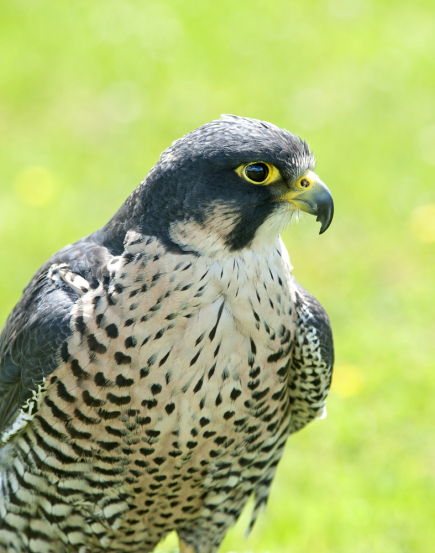Let’s dive deep into the world of falcons and caracaras with these interesting facts.
Witten by: Niki Giovanis
What are Falcons and Caracaras?
Falcons and caracaras are two types of birds that belong to the same order, called Falconiformes. Both falcons and caracaras are classified as being birds of prey. If you remember from our previous article about eagles, which are also classified as birds of prey, you will remember that these types of birds are also commonly referred to as raptors. In other words, birds of prey, including falcons and caracaras, hunt and feed on vertebrates, which are a type of animal that has a spinal cord like humans! However, unlike other birds of a prey, such as eagles, hawks, and vultures, who are relatively large in size compared to other birds, both falcons and caracaras are small to medium in size.

How Many Species of Falcons and Caracaras are There?
There are approximately 60 species of falcons and caracaras that make up the Falconiformes order.
Physical Characteristics
As mentioned earlier, unlike other raptors, falcons and caracaras are characterized as being relatively small to medium in size depending on their subspecies that range from approximately 14 cm – 65 cm(5.5 inches to 2 feet, 1.6 inches) in length, and 28 grams to 2.1 kg(0.988 ounces to 4.6 pounds) in weight, which is lighter than what you may have assumed! They have powerful hooked beaks, sharp talons to capture the prey, and of course, impeccable eyesight like other raptors. In terms of their feathers’ color, these species of birds typically embody deep browns, black, white, gray, and in some cases, have a patterning throughout their feathers. Interestingly enough, unlike other bird species, females are larger than males.
Where do Falcons and Caracaras Live?
Falcons can be found on every continent with the exception of the high arctic and Antarctica, where they inhabit forests, tundra, and deserts . Caracaras can be found in the southern United States, and Latin America, where they inhabit grasslands, desserts, and scrublands.
Falcon and Caracara Reproduction
As do other species of birds, Falconids have rituals in courting a mate, such as showing their flying abilities. However, unlike caracara species who build a nest together once they have settled with their chosen mate, falcons burrow in the cavity of a rock or tree holes. Like many bird species, the mates will remain monogamous.
Furthermore, both falcon and caracara species breed once a year and typically lay one to six eggs. Further, female Falconidae species incubate their eggs while the male birds hunt for prey. Additionally, the incubation period varies between different species, anywhere from 28 to 35 days. However, smaller subspecies such as the falconets incubate for shorter periods in comparison to larger species such as gyrfalcons.
The Falconidae Diet
As mentioned previously, these birds are carnivores that prey on other birds, reptiles, and small mammals. However, their diets will vary from species to species and depending on what region in the world they live in! For example, the peregrine falcon feeds mainly on other birds. In contrast, caracaras prey on larger animals, fruits, lizards, insects, fish, and even frogs.
Furthermore, in terms of hunting methods, this varies depending on their diets and can range from using their speed to strike their prey, swoop down to catch their prey off guard, or run on land to catch insects and other types of prey.
Now that we have a clear understanding of the Falconidae family let’s further look into the Peregrine Falcon(Falco peregrinus). the peregrine falcon is one of the approximately 60 species classified in the Falconidae family.

The peregrine Falcon
Peregrine Falcons can be found on every continent except Antarctica. The Peregrine Falcon has a total wingspan of 75 to 1.2 cm(2’5.5″ to 3’11.2″), a body length of 34 to 58 cm(1’1.4″ to 1’10.8″). They can weigh anywhere between 330 grams to 1.5 kilograms(0.73 to 3.3 pounds).
In terms of hunting, they can reach speeds up to 320 km/h(198.8 mph) when they hunt as they are able to swoop throughout the air and dive to catch their prey, which is typically another species of bird such as ducks. How impressive is that?
Furthermore, depending on the region where they inhabit, they either lay their eggs between February and March if they are in the Northern Hemisphere or anytime within June and December in the Southern Hemisphere. The eggs are typically incubated anywhere from 29 to 33 days by the female as the male leaves the nest to find food.
Further falcon and Caracara Quick Facts
- Falcons and caracaras can live anywhere from 13 to 20 years, depending on their species. However, if humans raise them, they can live up to 25 years as they are able to be taken care of when they begin to get older and weaker.
- Falcons can travel up to 390 km/h(198.8 mph), caracaras can’t fly nearly as fast and are considered slow-flying birds.
- Falcons nearly went extinct in North America from the use of pesticides.
- Baby Crested Caracaras are hatched with their same distinctive dark heads that you see on adult caracaras.
- While some species of Falconidae migrate during the winter months, others stay localized in one central area.
Final Thoughts
As you can see, there are so many incredible and exciting pieces of information about these majestic species of birds. From their distinctive colorway to their impeccable flying abilities, falcons and caracaras are spectacular animals.
Niki Giovanis is a freelance writer who does not necessarily share the opinions expressed on BrantaMedia.com.
